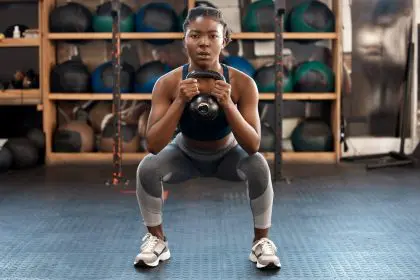You don’t have to hobble around for days after every workout to build strength. The idea that muscle soreness equals muscle growth is one of the biggest myths in fitness, and it’s keeping people from consistent training that actually builds real strength over time.
Learning how to get stronger without getting sore is about training smarter, not harder, and understanding that sustainable progress beats painful workouts every single time.
Progressive overload without the pain
The key to building strength without soreness is gradual progressive overload — slowly increasing the demands on your muscles over time. Instead of jumping from 10-pound weights to 25-pound weights overnight, increase by just 2.5-5 pounds per week.
This gradual progression allows your muscles, tendons, and nervous system to adapt without the severe breakdown that causes debilitating soreness. Your body builds strength through adaptation, not destruction, and small consistent increases create stronger adaptations than dramatic jumps.
Most people make the mistake of doing too much too soon, which creates excessive muscle damage and soreness that forces them to take days off from training. Consistency beats intensity when it comes to long-term strength gains.
Focus on frequency over intensity
Training the same muscle groups 2-3 times per week with moderate intensity builds more strength than training each muscle group once per week with maximum intensity. Higher frequency with lower volume per session allows your muscles to recover between workouts while still providing enough stimulus for growth.
This approach, called distributed practice, helps your nervous system learn movement patterns more efficiently while avoiding the excessive muscle damage that comes from infrequent, high-volume sessions.
Instead of doing 20 sets of chest exercises on Monday, do 7 sets on Monday, Wednesday, and Friday. You’ll get stronger faster and feel better doing it.
Master proper form first
Perfect technique is the foundation of getting stronger without getting sore. When you use proper form, you target the intended muscles efficiently without putting unnecessary stress on supporting muscles that weren’t meant to handle the load.
Poor form forces smaller stabilizing muscles to work overtime, leading to soreness in unexpected places and potential injury. It also prevents you from effectively targeting the muscles you’re trying to strengthen.
Take time to learn correct movement patterns with lighter weights before progressing to heavier loads. Your muscles will respond better to targeted work than to chaotic, inefficient movements.
The 80% rule for effort
Instead of training to complete failure every set, aim for about 80% of your maximum effort. This means stopping when you could probably do 2-3 more reps with good form. This approach, called autoregulation, provides enough stimulus for strength gains without the excessive fatigue that causes soreness.
Training to failure creates exponentially more muscle damage and fatigue than stopping just short of failure, but it doesn’t create proportionally more strength gains. The last few reps to failure often involve compromised form and excessive stress on your system.
Listen to your body during each set and stop when your form starts to break down or when the weight feels significantly heavier than it should.
Prioritize recovery between sets
Taking adequate rest between sets allows your muscles to recover enough to maintain good form and consistent effort. For strength training, rest 2-3 minutes between sets of compound movements and 1-2 minutes between sets of isolation exercises.
Rushing through workouts with insufficient rest forces your muscles to work in a fatigued state, leading to poor form, reduced effectiveness, and increased soreness. Quality work requires quality recovery, even during your workout.
Use rest periods to focus on proper breathing, mental preparation for the next set, and light stretching of non-working muscles.
Strategic exercise selection
Choose exercises that allow you to use proper form throughout the full range of motion. Compound movements like squats, deadlifts, and push-ups are generally better for building functional strength than isolation exercises because they train multiple muscle groups to work together.
However, if certain exercises consistently leave you sore, consider modifications or alternatives. For example, if regular squats cause excessive soreness, try goblet squats or box squats until your form and strength improve.
The best exercises are the ones you can perform consistently with good form, not necessarily the most advanced or impressive-looking movements.
Nutrition timing for recovery
Eating protein within 2 hours after training helps your muscles recover and rebuild without excessive soreness. Aim for 20-30 grams of high-quality protein along with some carbohydrates to replenish energy stores and support recovery.
Staying hydrated before, during, and after workouts also helps prevent the muscle cramps and excessive soreness that can come from dehydration. Dehydrated muscles are more prone to damage and slower to recover.
Don’t train on an empty stomach if you want to avoid soreness — having some fuel in your system helps your muscles work more efficiently and recover better.
Sleep is your secret weapon
Quality sleep is when your body actually builds the strength gains you’re working for. During deep sleep, your body releases growth hormone and repairs muscle tissue without the inflammation that causes soreness.
Most people who consistently get 7-9 hours of quality sleep experience less muscle soreness and better strength gains than those who are chronically sleep-deprived.
Create a consistent sleep schedule and prioritize good sleep hygiene to maximize your recovery and minimize soreness.
Listen to your body’s signals
Your body will tell you when you’re pushing too hard. Excessive soreness lasting more than 48 hours, decreased performance, or feeling run down are signs that you need to dial back the intensity or take an extra rest day.
Strength training should energize you, not drain you. If you’re consistently sore and tired, you’re likely training too hard too often.
The consistency advantage
When you learn how to get stronger without getting sore, you can train more consistently, which leads to better results than sporadic intense sessions followed by forced rest days.
Consistent, moderate training beats inconsistent, intense training every time when it comes to building lasting strength.
Bottom line? Getting stronger without getting sore is about training smart with progressive overload, proper form, adequate recovery, and listening to your body. Sustainable strength gains come from consistent practice, not from punishing workouts that leave you unable to train effectively.
















